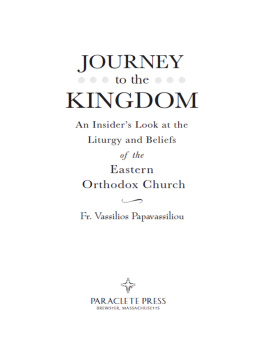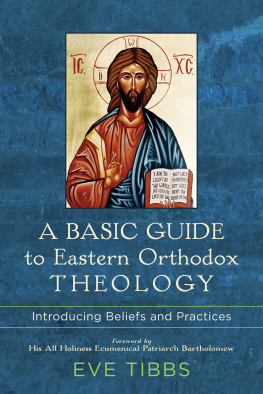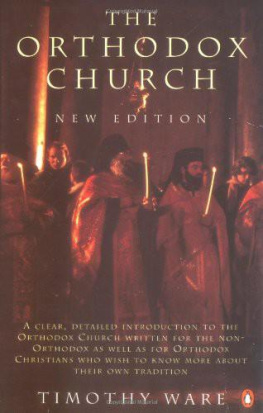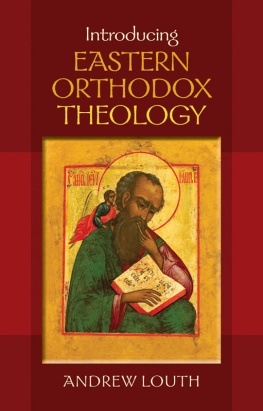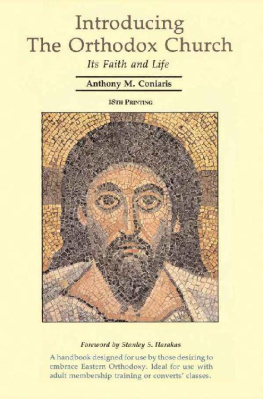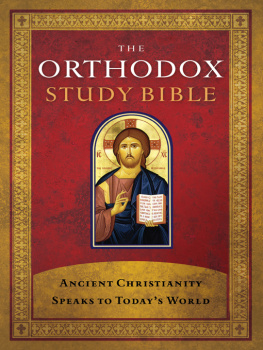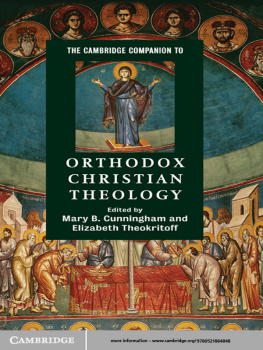THE EASTERN ORTHODOX CHURCH

Published with assistance from the foundation established in memory of Calvin Chapin of the Class of 1788, Yale College.
Copyright 2020 by Yale University.
All rights reserved.
This book may not be reproduced, in whole or in part, including illustrations, in any form (beyond that copying permitted by Sections 107 and 108 of the U.S. Copyright Law and except by reviewers for the public press), without written permission from the publishers.
Yale University Press books may be purchased in quantity for educational, business, or promotional use. For information, please e-mail (U.K. office).
Set in Janson type by IDS Infotech Ltd.
Printed in the United States of America.
Library of Congress Control Number: 2019948578
ISBN 978-0-300-21876-3 (hardcover : alk. paper)
A catalogue record for this book is available from the British Library.
This paper meets the requirements of ANSI/NISO Z39.48-1992 (Permanence of Paper).
10 9 8 7 6 5 4 3 2 1
For the Family of Saint Gregorys Orthodox Chaplaincy, Manhattan
Contents
PRELUDE
The Naming of Parts
H ENRY R EED (19141986), a friend of the poets W. H. Auden and Louis MacNeice, was a witty and acutely intelligent twenty-seven-year-old when he was conscripted into the British armed forces during World War II. He was set to work (with no previous facility or experience) to serve as a translator of Japanese, and would later quip that the brightest benefit of peacetime was that he would never have to study another word of the language as long as he lived. His most famous poem is his satire on British Army officious inefficiency, Naming of Parts. Even when the recruits had no actual equipment with which to fight, they were required, in a formal daily drill, to learn names of all the broken-down parts of their (nonexistent) guns, from the example of the one weapon the drill sergeant showed to them: Today we have naming of parts. Yesterday, / We had daily cleaning. And tomorrow morning, / We shall have what to do after firing.
The naming of parts is a tedious business at the best of times, and the mind would always prefer to flit to more glistening bitsJaponica, coral, gardens with fragile blossoms, which Reed immediately goes on to talk about in his poembut when it comes to highly controverted terms and concepts, it is maybe a good place to start.
Even the title of The Eastern Orthodox Church: A New History will introduce several such parts. Ninety-six thousand words may not be short enough for some, but we must let that pass. A workably brief history of something as old as two millennia in so short a space may be inconceivable for others. The designation Eastern may itself be confusing; when I, for example, who am a member of the Eastern Church, come from Wallsend in the North of England and formerly served a community in New Yorks Harlem neighborhood. I myself was much confused when, dressed in the robes of an Orthodox archpriest at an ecumenical convention, I was approached by some well-meaning Protestant minister delegate who wished me Happy Passover and wondered why I was not wearing payot sidelocks and a hat. It took me a few moments to realize he had confused his Orthodoxes. But today we have the naming of partsfor what I wish to begin with is a few comments on what that last little word Church might mean; and that is a question that underlies both the logic of how I might make a short historical account of Orthodox Christianity in the first place, and also how the Orthodox Church can be rightly placed among the other, perhaps more well-known, forms of Christian tradition.
Why I think it is necessary to have this shuffling of feet at the very outset is because Eastern Orthodoxy refuses to call itself, or see itself, as a denomination. I used to have But the serious aspect to it was that a very common modern approach to the history of the Christian Church takes its beginnings from the present-day great diversity of churches. Denominationalism is a preferred way in our time of dealing with the fractions of Christendom that occurred especially after (but existing long before) the era of the Reformation. Today, without the notion of denominations and the idea that there are multiplicities of Christian churches, most can hardly comprehend the idea of what the word church might mean. The fundamental creed of Christendom, the Nicene-Constantinopolitan statement of faith that most Christians acknowledge, and some churches recite regularly at worship, states as one of its articles of faith that the Church of Christ is: One, holy, catholic, and apostolic. But even those Christians who publicly profess those words, week after week, would be hard put to say how Christianity reconciles the concept of fundamental unity (that the church is one) with the multiplicity we see with our eyes. So Orthodoxys claim not to be one of the Christian churches but rather the Church of Christ is a rather big one that needs addressing up front.
So let me state up front that this will be a focused history of the Byzantine Orthodox traditionthe definition of Eastern Orthodox Christianity that includes, today, the Greek, Russian, and Romanian Orthodox Churches (the big communities), as well as the Serbs, the Bulgarians, the Georgians, the Orthodox churches of Antioch and Jerusalem, of Poland, For this reason the present account looks only very cursorily at the so-called Oriental Orthodox churches. In the latter case the word Oriental refers to the Provincia Orientalis of the late Roman Empire (not the manner in which English language used to use the word Orientalism pejoratively), because these churches in ancient times used to be located mainly there, in what is now Syria, Egypt, and Ethiopia, and nowadays we would add to that communion the Armenian Church. These are collectively also described as the Non-Chalcedonian Orthodox churches, for they recognize the high authority only of the first three Ecumenical Councils.
To tell the story of the ancient Eastern Orthodox Church, incarnated in a scintillating array of local churches of different language groups and national traditions, is a task of no small order. But as the old saying goes, A journey of a thousand miles begins with a small step, and this book is best begun by walking down the road that takes us from Jesus to the classical patristic age in the fourth and fifth centuries. By that time many of the more recognizable forms of Eastern Orthodox tradition are set in place and become familiar. Western Catholicism, after Cardinal Newman, often likes to talk about its history and culture in developmental terms and images. Orthodoxy prefers to understand itself in terms of organic wholeness. If we compare the church to a piece of great music, the early centuries within the first half of the first millennium are like the establishment of the major themes: subthemes commenting on the primary themes of the Gospels. The later centuries are like the variations, all trying to be faithful to the spirit and intelligence (the ethos) set up by the primary inspirationbut carried on with equal inspiration (the music endures with authority) even to the end that is still to come.
Anyway, let us begin that task, since it is a long journey, with a protohistory of the church, as it were, for a commonly held theory among some scholars today is that the church never existed as a single coherent unit or factor; such was its diversity that unity and uniformity had to be an anachronistic concept foisted on it retrospectively, and so Orthodoxys claim to be this church is impossible. This is a view partly behind the great delight in reclaiming suspiciously lost Gospels: as if they represented viable forms of alternative Christianity pushed aside by an oppressive orthodoxy. Where this supposed oppressive power came from in the pre-third-century church is never explained, of course. Against the myth that these allegedly lost Gospels (which the church had generally preserved in its record anyway) were of fundamental significance and offered a powerful alternative, I always used to say to students: Read them for yourselves and then tell me which, if you had to buy one, would you prefer: the Gospel of John or the Gospel of Truth? The Gnostic literature and the apocryphal literature were rejected by the church at large well before there was any universal authority structure in place to ostracize them. They were rejected for exactly the same reasons our contemporary bookshops carrying remaindered books are able to find their stock. They are, in short, the remaindered literature of Christian antiquity and (as is generally the case) remaindered for good reason. To the claim that there never was a single Christian Church with coherent unified doctrinal positions, Orthodoxy answers, of course: Yes there was, and we are it; and our history demonstrates that core and essential history of the unified church. This attitude, I would maintain, is universally typical of Orthodox churchmen and -women when asked to characterize or discuss their church. Such a stance often causes confusion and maybe even some degree of offense among other Christians who hear it; thinking, perhaps, that this claim that they themselves are the church somehow implies that all others are not recognized as Christians in their own right; as Roman Catholics or Protestants, for example. But this latter implication is not intended by most Orthodox, who in this robust and singular sense of being church, and professing to be the direct and unbroken continuance of the early church, are more concerned with maintaining and stating what they regard themselves as being, rather than defining, what a widely differentiated Western Christianity has become.
Next page



